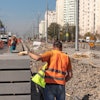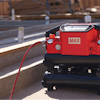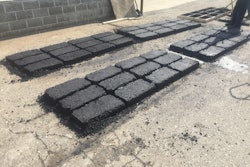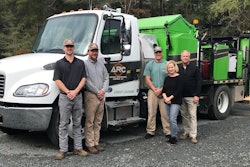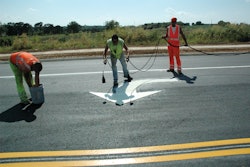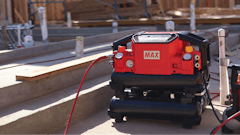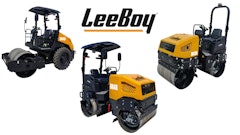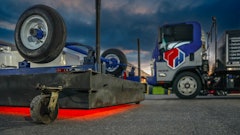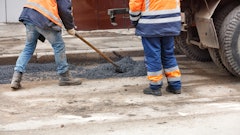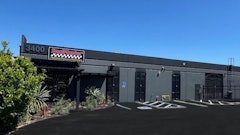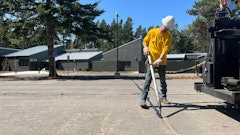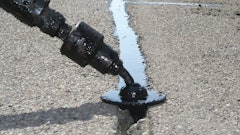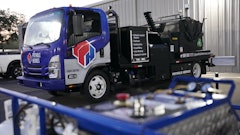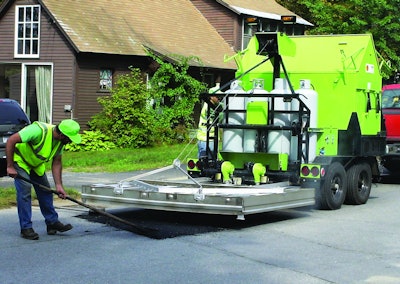
Infrared asphalt services are growing in popularity. Contractors have a multitude of equipment options available to them. So how does a contractor go about selecting the right infrared equipment for his or her business?
The options
"Every contractor should own some form of infrared equipment," says David Strassman, owner of Asphalt Reheat Systems. An infrared unit allows contractors the ability to make repairs right away without having to schedule a subcontractor to come in and handle the work. "The more you can do in house the more control you have," Strassman adds. "Infrared equipment has given contractors independence."
Contractors need to be aware of the different options available. "Every infrared unit is a little bit different," Strassman says. But there are three general categories of infrared units: portable (walk-behind), trailer mounted, and truck mounted.
All three categories of infrared units can be used for pothole repair, joint heating, thermoplastic application, decorative asphalt, and many other applications that require reheating and/or repairing asphalt.
The most prominent heating chamber size is 6x8 ft., says Ray-Tech President Wes Van Velsor. The 6x8 heating chamber is versatile and can fit most infrared situations. But heating chambers are available in sizes both smaller and larger depending on the type of equipment it is on and the manufacturer because no one infrared unit can fit all situations, Van Velsor adds.
Portable. These units are often used in tight places or for smaller jobs, says Tom Allen, general manager for Kasi Infrared. Contractors can use this type of unit if infrared services are a minor part of their business. It also makes for a good supplementary unit to larger infrared equipment. "Contractors can use these units without tying up their big units for small jobs," Allen says.
These smaller, mobile units are usually a good solution for parking lot or driveway repairs, says Kurt Schwarz of KM International. They are usually easier to move from repair to repair.
Contractors just starting in the infrared business, or those who have a smaller size area to heat or less volume to patch, may find these portable units can be more economical to transport and a better fit for their initial capital investment, says Bob Kieswetter, president of Heat Design Equipment
Asphalt Reheat Systems' most popular unit is its portable system. The 4x4 split box unit was always the top seller for the manufacturer, but the newer 4x6 split box unit has grown in popularity. The split box design allows contractors the option to heat either a 2x4 or a 4x4 area with the 4x4 unit or a 2x6 or 4x6 area with the 4x6 unit. These portable units are lightweight and can be operated by one person, Strassman says. Small- and medium-sized companies gravitate toward this unit, he adds.
Another unique portable option is the Thermotrack infrared unit. The 6x9-ft. heating area elements on this unit run on a belt-driven track to move across the heating surface. The unit allows the operator to keep visual contact on the asphalt being heated, says Thermotrack Owner and President Greg Larsen. The non-stationary heating elements also allow the unit to deep heat the asphalt without overheating that creates surface damage, Larsen adds. Thermotrack recently introduced a new model of its infrared unit which features a new direct spark ignition.
Trailer systems. Trailer-mounted infrared units can have a variety of heating chamber sizes depending on the contractor's needs. These units can also incorporate a hot box to carry asphalt as well. These units are often longer than truck-mounted systems and can be a challenge to back up or position over a repair, Allen says.
The 4-48 trailer-mounted unit is the top seller for KM International, says Cliff Cameron of KM International. The unit offers four zones for a total of 48 square feet of infrared heating.
Ray-Tech's Mini Combo is the company's best selling trailer-mounted infrared unit, Van Velsor says. Ray-Tech touts its Mini Combo as a starter unit for the infrared industry. It features a 6x8-ft. heating chamber that can operator as one chamber or two 4x6-ft. heating elements. The unit also incorporates a 2-ton hotbox reclaimer on the unit.
Truck systems. Truck systems can provide contractors with a flexible, whole maintenance package, Kieswetter says. Like trailer systems, truck-mounted infrared units can have varying heating chamber sizes and can incorporate a hot box as well. "Truck unites are usually considered the 'Cadillac' of infrared units," Van Velsor says. "They have everything you need on one vehicle."
Contractors doing infrared repairs on roads or long, straight ahead repair will find a truck-mounted unit more efficient than the smaller options, Schwarz says. It can be challenging to fit these units into tight places or on smaller repairs, though.
If purchasing a trailer or truck system, consider the size of the asphalt reclaimer/hot box. If you will be doing a lot of heating during the course of a day or will need a lot of asphalt you'll want a larger capacity unit, Van Velsor says.
Kasi's most popular unit is its 4-ton truck-mounted Patriot with a 6x8-ft. chamber. "This unit only takes a two-man crew to operate, and it has every thing on one truck chassis," Allen says. Sealcoating and striping contractors make up the biggest customer segment for this unit.
Some infrared units can also be mounted directly to asphalt pavers, such as Heat Design Equipment's best selling Joint Heaters. These joint heaters are most popular with larger highway paving operations and can be used to reheat a cold joint to create a seamless road and prevent early deterioration, Kieswetter says. Kieswetters says contractors generally connect 16 to 20 feet of joint heaters to a paver. The heat created by these infrared joint heaters penetrates the depth of the surface course to allow recompaction of the asphalt at the joints.
What to Consider
Contractors have a lot to think about before purchasing an infrared unit. Two of the most important determining factors include budget and size of repairs being done. Once a budget is set, ask more specific questions to find the best equipment option. Strassman says contractors need to also consider the cost to purchase versus the costs to operate and maintain the unit as well.
Contractors who currently subcontract repair work should consider whether it make sense to continuing subbing or to have an in-house crew? And profit-wise, does it make sense to augment your business with this type of service, Allen asks. Are you seeing enough demand for the service on your jobs?
Demand is the biggest determining factor when it comes to selecting infrared equipment, Van Velsor says. Degree of acceptability often influences demand. Some areas may not be as familiar with infrared services, which means contractors will also have to invest more time and money into selling these services, Kieswetter points out. But he also suggests contractors be proactive in promoting and offering infrared services no matter the degree of acceptability. "You need to teach the client what infrared can do," he says. "The environment is there for infrared to grow."
Consider your target market, Larsen suggests. Is there demand in your area in this target market? A contractor might intend to only use the equipment for one service but it isn't long before customers start asking for other infrared services, Larsen adds. Consider what you intend to use it for in the beginning and what you might use it for down the road.
Will it be used more on parking lots or streets, Cameron asks. Will you be working more with residential or commercial customers? Will it be used for patching, oil spot repair, thermoplastic application, decorative asphalt, or something else?
Consider the size of your infrared crew. Will you have a dedicated infrared crew or will you train all your employees on how to use the equipment? Strassman says a typical crew of two to three people can efficiently use an infrared unit without anyone standing around. If you plan to have a larger infrared crew, consider whether you can get more production with multiple infrared units.
The area of the country you work in should also be considered. Asphalt will vary across the country. If you'll be repairing harder asphalt you'll need to consider that, Van Velsor says. Temperature also factors into the decision. Will you be using the equipment in colder environments? Asphalt coolers down faster in colder environments, so a larger area of the asphalt may need to be heated. In that case, Van Velsor suggests purchasing a larger unit to heat efficiently in cold temperatures.
After answering these questions, if you are still confused, Cameron says to talk to infrared manufacturers. They can often recommend the best unit for what you want to accomplish.
Contractors should do all their homework before making a purchasing decision. Van Velsor recommends a thorough investigation when making a purchase decision. Call contractors currently using the equipment. And make sure to test the equipment yourself before purchasing, Larsen adds.
Final Thoughts
Strassman says contractors should make the final decision based on the size of patch or asphalt reheating the company will be doing most often. If the size of work is on the small side there is no need for a large unit. On the other hand, if the area of work leans toward the larger size, a smaller unit might not be the most efficient option.
Larsen suggests contractors look for a unit that will offer them the most versatility both in size of the heating area and uses for the equipment. Is it mobile enough for the jobs you'll be using it on?
"Buy the size that will give you the most production," Strassman says. Consider what you want your production to be based on the crew size you have to work with. "Sometimes contractors have the tendency to buy way too big. You can only heat as much as you can finish. Don't go bigger than you can handle," he adds.

